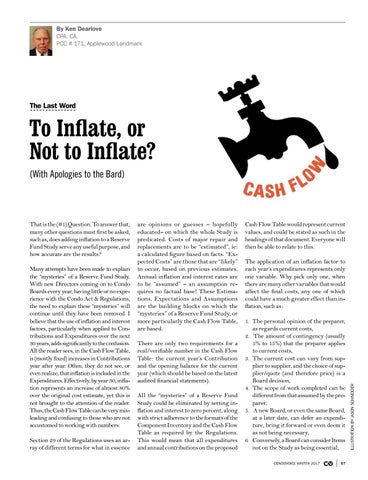By Ken Dearlove CPA, CA. PCC # 171, Applewood Landmark
The Last Word
To Inflate, or Not to Inflate? (With Apologies to the Bard)
Many attempts have been made to explain the “mysteries” of a Reserve Fund Study. With new Directors coming on to Condo Boards every year, having little or no experience with the Condo Act & Regulations, the need to explain these “mysteries” will continue until they have been removed. I believe that the use of inflation and interest factors, particularly when applied to Contributions and Expenditures over the next 30 years, adds significantly to the confusion. All the reader sees, in the Cash Flow Table, is (mostly fixed) increases in Contributions year after year. Often, they do not see, or even realize, that inflation is included in the Expenditures. Effectively, by year 30, inflation represents an increase of almost 80% over the original cost estimate, yet this is not brought to the attention of the reader. Thus, the Cash Flow Table can be very misleading and confusing to those who are not accustomed to working with numbers. Section 29 of the Regulations uses an array of different terms for what in essence
are opinions or guesses – hopefully educated– on which the whole Study is predicated. Costs of major repair and replacements are to be “estimated”, ie: a calculated figure based on facts. “Expected Costs” are those that are “likely” to occur, based on previous estimates. Annual inflation and interest rates are to be “assumed” – an assumption requires no factual base! These Estimations, Expectations and Assumptions are the building blocks on which the “mysteries” of a Reserve Fund Study, or more particularly the Cash Flow Table, are based. There are only two requirements for a real/verifiable number in the Cash Flow Table: the current year’s Contribution and the opening balance for the current year (which should be based on the latest audited financial statements). All the “mysteries” of a Reserve Fund Study could be eliminated by setting inflation and interest to zero percent, along with strict adherence to the formats of the Component Inventory and the Cash Flow Table as required by the Regulations. This would mean that all expenditures and annual contributions on the proposed
Cash Flow Table would represent current values, and could be stated as such in the headings of that document. Everyone will then be able to relate to this. The application of an inflation factor to each year’s expenditures represents only one variable. Why pick only one, when there are many other variables that would affect the final costs, any one of which could have a much greater effect than inflation, such as: 1. The personal opinion of the preparer, as regards current costs, 2. The amount of contingency (usually 5% to 15%) that the preparer applies to current costs, 3. The current cost can vary from supplier to supplier, and the choice of supplier/quote (and therefore price) is a Board decision, 4. The scope of work completed can be different from that assumed by the preparer, 5. A new Board, or even the same Board, at a later date, can defer an expenditure, bring it forward or even deem it as not being necessary, 6 Conversely, a Board can consider Items not on the Study as being essential, CONDOVOICE WINTER 2017
CV
67
ILLUSTRATION BY JASON SCHNEIDER
That is the (#1) Question. To answer that, many other questions must first be asked, such as, does adding inflation to a Reserve Fund Study serve any useful purpose, and how accurate are the results?
